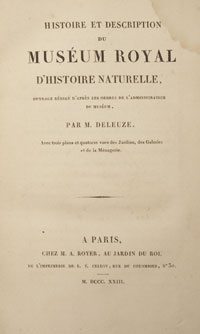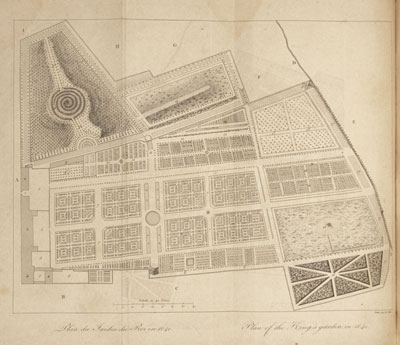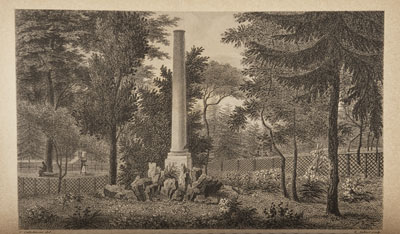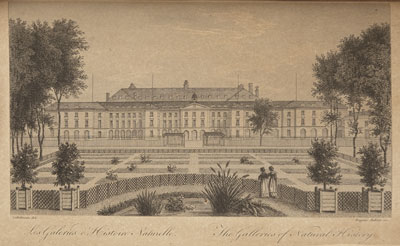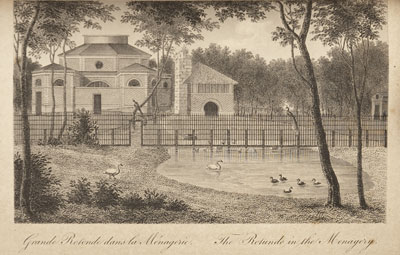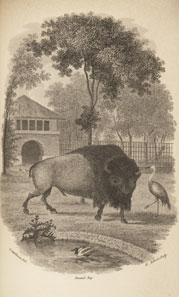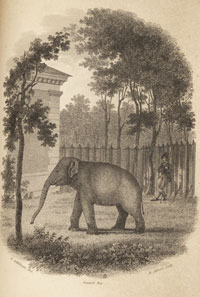Deleuze, J. P. F. (Joseph Philippe François), 1753–1835, Histoire et description du Muséum Royal d'Histoire Naturelle, ouvrage rédigé d'après les ordres de l'administration du muséum (Paris, 1823)
Click on the images to enlarge
Owing to its relationship to the Whipple Museum, one of the Whipple Library's collection strengths is in the history of museums, of which this recent acquisition is an important example.
Published in 1823, this is an account of an institution central to the history of natural sciences, written by its librarian at a key point in its development. By the second decade of the 19th century the Muséum Royal d'Histoire Naturelle (now known as Musée national d'histoire naturelle) had been the focus for the careers and research of many figures now considered pre-eminent in the history of sciences including Georges-Louis Leclerc, Comte de Buffon, the eminent evolutionary pioneer Jean-Baptiste de Lamarck and the chemist Michel Eugène Chevreul.
Situated near the quai Saint Bernard on the Seine, the Museum was founded in 1793, during the French Revolution although its origins lie in the Jardin Royal des plantes médicinales created by King Louis XIII in 1635. By 1823 the Museum was enjoying a golden age, having transformed from being an obscure medical garden serving students to the world's foremost centre for natural history.
The publication of Deleuze's book constitutes recognition of this period as a golden age in the history of the institution. Organised into two volumes, the first provides an account of the Museum's history which Deleuze divided into three 'époques' (1635–1739; 1739–1788; 1788–1823). The second of these époques is delineated by the career at the Museum (beginning 1739) of the hugely influential naturalist, mathematician and encyclopedic author Georges-Louis Leclerc, Comte de Buffon (1707–88).
This plan illustrates the institution's layout as it was in 1640 when it was known as Le Jardin du Roi. It had been founded as a Royal Physic Garden by Louis XIII. Deleuze includes plans of the institution's grounds for each of its three époques, thereby revealing the expansion and transformation that had taken place over the previous 200 years.
Deleuze also listed 'Principaux Employés' of the Museum as of 1822 (including himself), many of them now esteemed as central to the history of 19th-century science, along with accounts of their work and publications. Since the Revolution the Museum had been equipped with twelve professorial chairs, covering every aspect of 'nature's tableau'. On account of the vast resources allocated by central government to it at that time, the Museum was able to back ambitious projects, further enhancing its position as an internationally recognised centre of natural history. For example, following his listing of 'Principaux Employés' Deleuze provided an account of voyages all over the globe undertaken by naturalists connected to the Museum (Saint-Hilaire, Sauvigny, Le Seur and others) in order to acquire samples with which to enrich the Museum's collections.
The Museum's gardens contained the tomb of one of the Museum's noted former employees, the naturalist Louis-Jean-Marie Daubenton (1716–1800). He had provided anatomical descriptions for de Buffon's monumental 36 volume Histoire naturelle, générale et particulière (1749–1788).
The Galleries of Natural History
In volume two Deleuze described the then unrivalled resources of the Museum which included its library, hot houses, greenhouses, botanical galleries, collections of geology, mineralogy, live mammals, birds, fish, shellfish as well as anatomical specimens.
A principal aim of the Museum was to make available for study living plants and animals. The Museum's gardens were intended to be 'the most beautiful in the universe' where could be found the rarest animals and plants from all climates.
Each animal was to be placed in the situation most suited to it with trees and plants consistent with its natural habitat. Deleuze provided in his book extensive lists of mammals, birds and reptiles then living in the Museum's menagerie together with engravings of them in the Museum's grounds.
In the years following the publication of Deleuze's book the pre-eminence of the Muséum Royal d'Histoire Naturelle would wane. As French science suffered a general decline and funds were diverted to other scientific institutions in France, elsewhere bodies such as the British Museum and the Museum of Comparative Zoology at Harvard increasingly surpassed the Muséum Royal d'Histoire Naturelle.
Written when the Muséum Royal d'Histoire Naturelle was at its zenith in terms of prestige and achievement, Deleuze's proud account provides a rare and valuable insight into the workings of an institution of fundamental importance to the history of natural science. It also reveals to us a typically French perspective upon French science of the period and its history over the previous 200 years and thus constitutes an important historical document.
Further Reading
- Emma Spary, Utopia's garden : French natural history from Old Regime to Revolution (Chicago, 2000)
- Emma Spary, Making the natural order : the Paris Jardin du Roi, 1750–1795, University of Cambridge : Ph.D. Dissertation, 1993.
- Camille Limoges, 'The development of the Muséum d'histoire naturelle of Paris, c. 1800–1914' in: Robert Fox and George Weisz (eds) The Organization of science and technology in France, 1808–1914 (Cambridge, 1980)
Tim Eggington

